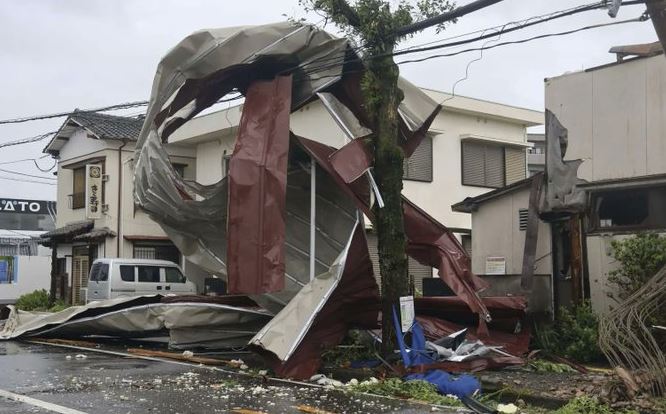Typhoon Shanshan unleashed severe weather on southern Japan on Thursday, causing significant destruction and claiming at least three lives as it slowly progressed up the archipelago. The typhoon made landfall near Satsumasendai in southern Kyushu, bringing torrential rains and ferocious winds.
The Japan Meteorological Agency (JMA) has issued its highest-level warnings, forecasting up to 60 cm (23.6 inches) of rain within 24 hours in affected areas. The storm’s sustained winds reached 144 kph (89 mph), with gusts reported at 252 kph (157 mph), prompting urgent safety advisories.
Also Read: Senegal Halts Mining to Protect Faleme River and Local Communities
In Kagoshima prefecture, where Shanshan struck around 08:00 local time (23:00 GMT), three fatalities have been confirmed. A couple in their 70s and a man in his 30s were part of a family of five whose home was destroyed in Gamagori before the typhoon made landfall. The other two family members, women in their 40s, were rescued following extensive overnight recovery operations, according to local broadcaster NHK.
The storm has led to significant infrastructure disruptions, with approximately 255,000 households experiencing power outages. Heavy rains have caused trees to sway, tiles to be blown off roofs, and debris to scatter, as seen in various online videos.
In response to the severe conditions, major automobile manufacturers such as Toyota and Nissan have halted production at their plants to ensure employee safety and address potential parts shortages. Additionally, hundreds of flights and several high-speed train services have been cancelled or suspended.
Local governments had issued evacuation advisories earlier in the week. Approximately 810,000 people in Shizuoka prefecture on Japan’s main island of Honshu were advised to evacuate, along with 56,000 residents in Kagoshima on Kyushu.
As Typhoon Shanshan continues its path, it is expected to approach Japan’s central and eastern regions, including Tokyo, over the weekend. The JMA’s special typhoon warnings are issued only for the most severe storms, a measure previously applied in September 2022 for Typhoon Nanmadol, marking a significant precedent for Kyushu.
Shanshan follows Typhoon Ampil, which earlier this month caused minor disruptions, and Tropical Storm Maria, which led to record rainfall in northern Japan. Recent studies indicate that climate change is contributing to the increased intensity and prolonged duration of typhoons in the region.
Key Points:
- Typhoon Shanshan Hits Southern Japan:
- Landed near Satsumasendai in southern Kyushu on Thursday.
- Severe Weather Conditions:
- Up to 60 cm (23.6 inches) of rain expected in 24 hours.
- Sustained winds of 144 kph (89 mph) with gusts up to 252 kph (157 mph).
- Fatalities and Injuries:
- At least three confirmed deaths: a couple in their 70s and a man in his 30s.
- 39 people injured in Kagoshima and Miyazaki prefectures.
- Infrastructure Impact:
- 255,000 households without power.
- Significant damage reported, including uprooted trees and debris.
- Disruptions:
- Major car manufacturers Toyota and Nissan halted production.
- Hundreds of flights and high-speed train services cancelled or suspended.
- Evacuation Advisories:
- 810,000 people advised to evacuate in Shizuoka (Honshu).
- 56,000 residents in Kagoshima (Kyushu) also advised to leave.
- Future Impact:
- Typhoon expected to move towards central and eastern Japan, including Tokyo.
- Special Typhoon Warnings:
- Issued for Shanshan due to its severe intensity, a rare measure for regions outside Okinawa.
- Recent Typhoons:
- Shanshan follows Typhoon Ampil, which caused minor disruptions, and Tropical Storm Maria, which led to record rainfall.
- Climate Change:
- Recent studies suggest climate change is intensifying typhoons, increasing their duration and impact.



